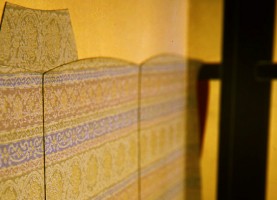

表具は表装とも呼ばれ、 経や書画を鑑賞に適するように裂地や紙を貼って裏打ちする技術として、仏教とともに中国から伝わりました。その後、掛軸、ふすま、額、屏風、巻物、画帖などへと 表 具・ 表 装の世界は広がりを見せていきました。最近では洋風建築の室内装飾へも進出しているほか、文化財の修復といった分野でも、その高度な技術を発揮しています。古くから芸術や宗教の中心地であった京都が育んだ、独特の工芸ということができ るでしょう。
Mounting in the Japanese context refers to providing a backing of cloth of paper enabling scrolls, calligraphy, and drawings to be displayed or viewed, and was introduced with Buddhism to Japan from China. Basic mounting techniques were later adapted for use with hanging scrolls, fusuma sliding doors, picture framing, decorative screens(byobu), hand scrolls, and picture albums. While similar mountings are used to decorate Western-style homes today, another important field is repairing and caring for historical assets. Kyoto’s history as a center for religion and the arts promoted the growth of this unique art form.
紙と布で作られる日本のインテリア、屏風
美しい布を選んで世界に一つのデザインを
Japanese folding screens: paper and material Japanese interiors. You can choose the most beautiful cloth for a completely unique design.



